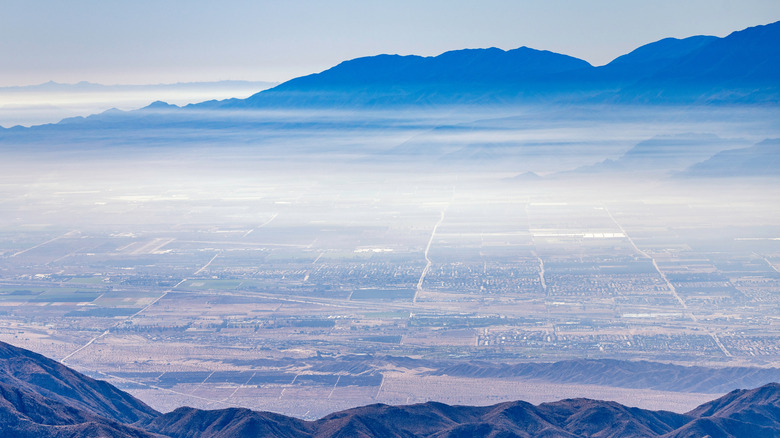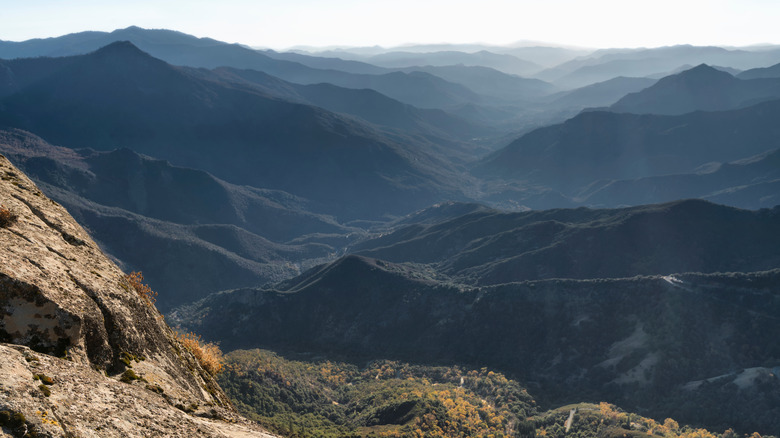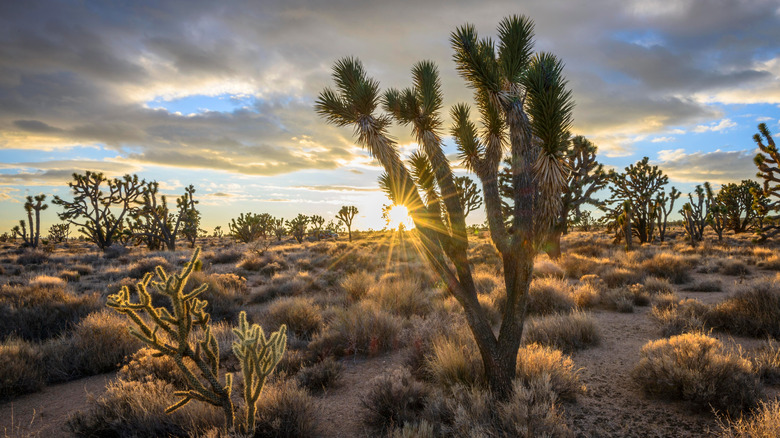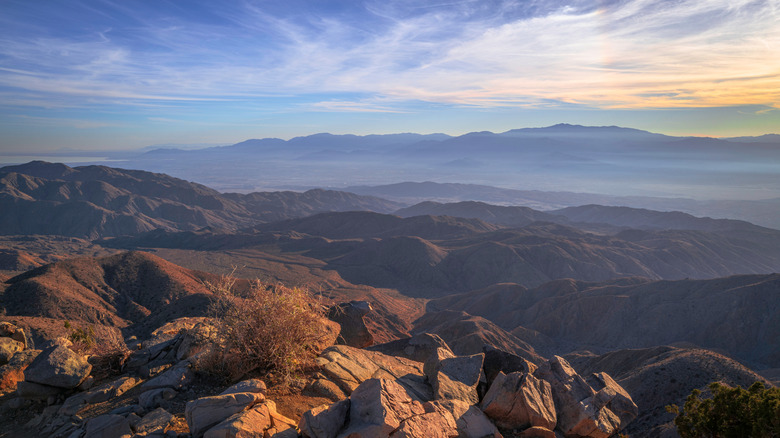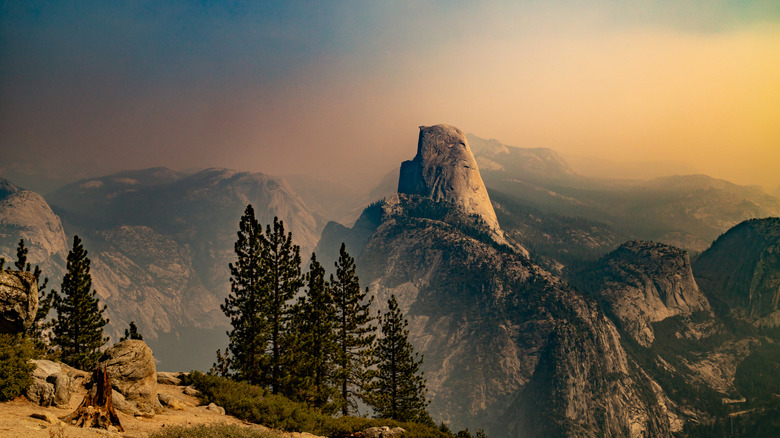Four Of America's Five Most Polluted National Parks Are All In One Scenic State Out West
When you picture national parks, you might imagine mighty forests, white sand dunes, or snow capped mountain peaks — but what about smog? While the national parks exist to help preserve the natural landscape in remarkable places around the United States, that doesn't mean that those beautiful spots are exempt from the pollution that impacts the world around them. According to a study from the National Parks Conservation Association which analyzed air quality and the impacts of climate change, the five parks that have the most significant issues with pollution are Sequoia and Kings Canyon National Parks, Mojave National Park, Joshua Tree National Park, Yosemite National Park, and Carlsbad Caverns National Park. All of these incredible parks are located in the state of California, except for Carlsbad Caverns.
Carlsbad Caverns National Park, in New Mexico has an issue with ozone levels, which are a particular concern in the hottest months of summer. These can reach levels that are considered unsafe for the park and its guests due to nearby oil drilling. The rest of the parks on the list are all in the state of California. While these parks are among the most beautiful places in the world, they are not exempt from the pollution issues facing The Golden State as a whole, like large urban centers, industry, wildfires, and farming. While California may have the most severe issues, it is not alone — the National Parks Conservation Association reports that 97% of national parks have issues with air pollution.
Sequoia and Kings Canyon National Parks
Sequoia and Kings Canyon National Parks are technically a pair of parks, but considering that they are neighbors, it's unsurprising that they are equally polluted. According to the National Parks Conservation Association study from 2024, these two parks are tied for the worst air quality of any park in the United States. These two extremely popular parks are home to ancient sequoia trees, the tallest mountain in the contiguous United States, and breathtaking rugged landscapes. Unfortunately, visitors may find their views obscured by haze and their hikes made far more difficult by dangerous pollutants in the air. If you're hoping to get the best possible views, avoid visiting in the hot summer months and once you're inside the park, head up. At higher elevations, the air is cleaner. You can also keep an eye on the National Park Service's health advisories page to see if the day you're planning to visit will have unhealthy levels of air pollution.
The issues at these two parks are largely the result of climate change disasters, being so close to major highways, and pollutants that drift into the parks from the San Francisco Bay Area. While the parks remain spectacular, air pollution not only damages the environment, it also makes it harder to see the views that are the major draw for travelers. Sometimes smog can reduce the distance visitors can see by more than 65%. It's not just about the views, either. The bad air quality in Sequoia and Kings Canyon National Parks and the surrounding area may also be responsible for the death of millions of trees in the region while promoting invasive species and dangerous algae blooms.
Mojave National Preserve
Deep in the California desert, Mojave National Preserve is a remarkable landscape of wind-carved dunes, singing sand, and solitude. Unfortunately, this fascinating place is not as untouched by civilization as it might seem. While it might seem like an arid, inhospitable place, the desert is home to a vibrant ecosystem, and nearby cities and industry increasingly put the plant and animal life within the preserve at risk.
While the views along the Kelso Dunes Trail remain unbeatable, there is definitely decreased visibility in the park at times due to air pollution. At its worst, the pollution here can also pose health risks to visitors to the park. If you happen to be visiting on a day when the air quality is especially poor, you may want to consider heading to the northern part of the preserve, which is usually not as heavily impacted by pollution from the San Joaquin Valley and the Los Angeles Basin. Try driving along Kelbaker Road to see Joshua trees, lava flows, cinder cones, and in the springtime, many wildflowers.
Joshua Tree National Park
Joshua Tree National Park has some of the best sunset views in the world and, as an International Dark Sky Park, is among the best national parks in America for stargazing. Considering its reputation for clear, brilliant views, it may come as a surprise that Joshua Tree has a serious problem with air quality that significantly impacts visibility a lot of the time. Unfortunately, the park's proximity to major inhabited areas like the Los Angeles Basin and Coachella Valley adds to this issue. While the sky views in the park remain spectacular, the truth is that the air quality often reaches levels of pollution that are dangerous for humans. The particles in the air also make their way into the soil, where they create conditions that are inhospitable for native plants, making them more likely to be choked out by invasive species.
Exactly how much haze you'll have blocking your views at Joshua Tree National Park varies from day to day, but it can be extreme. Ground-level ozone can make visitors sick, too, and can be particularly dangerous for people with asthma or certain heart conditions. The National Park Service's health advisories page has alerts for Joshua Tree, so make sure to check for alerts before hitting the trails. You can also always check in at the visitor center and get the latest results before you go into the park. If you're planning a trip, try to avoid the hottest times of the year, since more ozone forms when temperatures are higher.
Yosemite National Park
People come from all over the world to see the towering mountains and mighty giant sequoias in Yosemite National Park, but if you come at the wrong time, your views could be hampered by air pollution. If you're hoping for the best views and the least polluted air, you will probably want to choose a spring canyon hike. In spring, not only will you trek past breathtaking waterfalls without the crowds, you also won't be breathing in the pollutants that often pervade the park in the summer and fall.
Like other California national parks, urban areas and industry cause major issues, but in Yosemite, the biggest threat to clean air might just be wildfires. Forest fires are a natural part of the environment in this area, but that doesn't mean that the smoke doesn't cause issues for visitors to the park. If you happen to be visiting Yosemite when there are fires, you may want to stay inside during the worst of the smoke and wear an N95 respirator when you do go outside. As the smoke recedes, keep an eye on the National Park Service's health advisories page and try to explore during the times of day when the air is cleaner. If you're planning to be outside for any length of time, choose higher altitude areas and avoid basins and valleys where smoke may collect.
